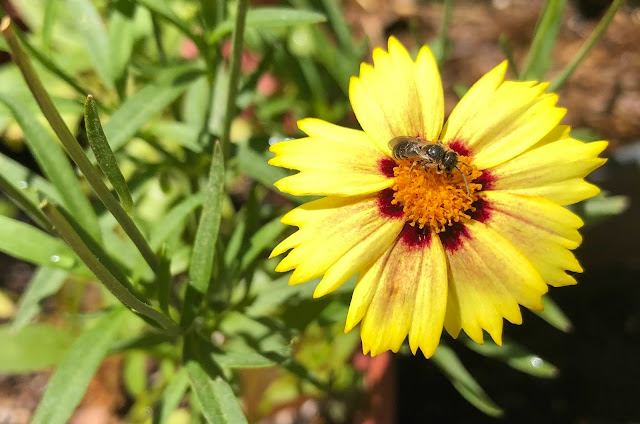
|
|
A ligated furrow bee (
Halictus ligatus
), part of the sweat bee family, pauses on a coreopsis blossom. Sweat bees have nests in the ground and are important pollinators. (Photo: Kathy Morrison)
|
Feel the buzz? It’s Pollinator Week, an international celebration of all things that pollinate flowers.
Continuing through Sunday, Pollinator Week includes all sorts of activities, big and small.
At UC Davis, the Haagen-Dazs Honey Bee Haven is celebrating with special activities.
On Thursday and Friday, June 24 and 25, the Been Haven garden will be staffed with experts who can answer questions related to bees and how to support pollinators in your own garden.
“We’ll also have our popular bee vacuums available so visitors may safely catch and observe bees,” the Bee Haven’s website notes.
Located on Bee Biology Road next to the Laidlaw Honey Bee Research Facility, the Bee Haven is open free to the public daily from dawn to dusk. In addition to honey bees, many species of native bees also make the Bee Haven their home.
For details and directions:
https://beegarden.ucdavis.edu/
Soil Born Farms is hosting a special hands-on introduction to pollinators just for kids. Open to children ages 7 to 11, “Pollinator Palooza” is set for 8:30 to 11:30 a.m. Thursday, June 24, at Soil Born’s American River Ranch, 2140 Chase Drive, Rancho Cordova.
“Through experiential learning, discovery and play, youth will deepen their connection to food, health and the environment,” say the organizers. “Participants will explore, create, learn, sing and enjoy the outdoors.”
The special emphasis during the pollinator class will be bees, butterflies and birds, with a chance to see several examples at the ranch. Class fee is $30 and advance registration is required. Sign up at
www.soilborn.org
.
Several local nurseries are celebrating Pollinator Week, too. Check out the Instagram posts for The Plant Foundry:
https://www.instagram.com/p/CQY3izuJvdQ/
Pollinator Week is coordinated by the Pollinator Partnership (or P2). Headquartered in San Francisco, the nonprofit partnership strives to protect native pollinating wildlife that’s so crucial to our ecosystem. (It also does a lot for honey bees.)
“Pollinator Week is an annual event celebrated internationally in support of pollinator health,” according to P2. “It's a time to celebrate pollinators and spread the word about what we can do to protect them.”
P2 started Pollinator Week about 20 years ago, and it has steadily grown along with awareness about the importance of pollinators.
“The great thing about Pollinator Week is that you can celebrate and get involved any way you like!” the group says. “Popular events include planting for pollinators, hosting socially distant garden tours, participating in online bee and butterfly ID workshops, and so much more.”
The Pollinator Partnership is trying to map celebrations online and spread the joy by using the social media hashtag #PollinatorWeek. See for yourself at
https://www.pollinator.org/pollinator-week.
(Among those sites already on the map: Filoli Gardens in Woodside. Details:
https://filoli.org/
)
Why are we so crazy about pollinators? We wouldn’t eat (much) without them.
About three-fourths of the world’s flowering plants need an animal pollinator to carry heavy pollen grains from plant to plant and fertilize flowers.
We tend to think of pollinators as honey bees or hummingbirds. But about 1,000 species of vertebrates – birds, bats and small mammals – are pollinators. Most pollinators (more than 20,000 species) are beneficial insects, including butterflies, moths, ants, wasps, beetles, flies and, of course, bees.
An estimated 1,000 food crops are dependent on pollination to produce fruit or vegetables. That includes apples, strawberries, blueberries, chocolate, melons, peaches, figs, tomatoes, pumpkins and almonds. In the U.S. alone, pollinated crops represent nearly $20 billion annually in products.
No wonder they call them busy bees!
Learn more at
www.pollinator.org
.

